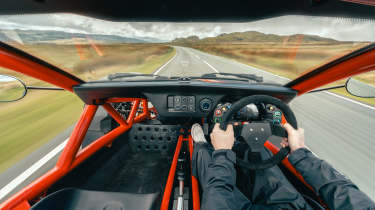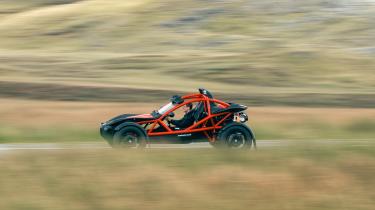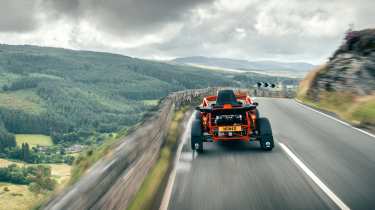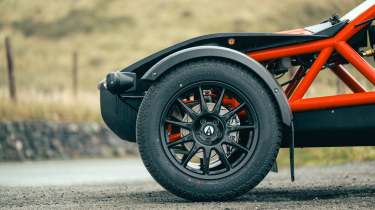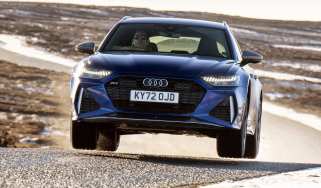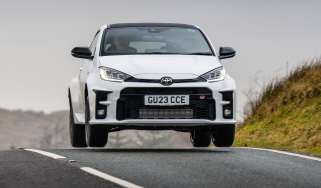Ariel Nomad 2 2025 review – does Ford beat Honda power?
evo is first to get behind the wheel of the follow-up to the ultimate recreational vehicle
The Ariel Nomad is a toy in the most emphatically positive sense of the word: an open-air two-seater capable of extreme off-road use, yet also uniquely brilliant fun on the road. The original launched in 2015 and captured customers’ imaginations in a way that took even Ariel itself by surprise. Nomad owners did all sorts with their cars – extreme off-roading, simple Sunday-drive-to-the-pub motoring, round-the-world expeditions, trackdays, and all points in between. It was the sports car the world never knew it needed.
Now it’s time for the follow-up: the ground-up-redesigned Ariel Nomad 2. We meet it in north Wales, and set about a pre-flight check to see what’s new, which is everything bar the steering wheel, pedal box and fuel filler cap.
'The evolution from Nomad 1 to Nomad 2 is similar to the step from Atom 3 to Atom 4,' explains Ariel MD Henry Siebert-Saunders, which is to say that while it may look very much the same, and is intended to have the same ethos and feel as its predecessor, it is effectively an all-new car. ‘It was the same scenario: what do we want to change? Nothing. What do we need to change? Everything.’
So Nomad 2 is easier to get into, faster and easier to manufacture and service, more reliable, able to carry more things more easily, even more capable off-road, and much faster on-road (and off it) than before. ‘But we’ve tried not to lose the Ariel-ness – the simplicity, the fun, the tactility,’ Siebert-Saunders emphasises.
More reviews
As Nomad 2 sits in a light mist of rain under low Snowdonian cloud, it packs much of the same visual impact as its predecessor. Its components are exposed like a cutaway drawing, yet it’s still one entity that your eye reads as a cohesive whole.
Whereas the original Nomad was based on the Ariel Atom 3, the new Nomad 2 is ‘more its own thing,’ Siebert-Saunders explains. Its front structure is very different from before, for example, with a 2.5 times bigger radiator for improved cooling. Its tubular frame comprises chassis and roll cage in one, as before, but it’s made from larger-diameter tubes than the original Nomad. Torsional stiffness is claimed to be increased by a full 60 per cent.
Overall dimensions are very similar to its predecessor’s but within that footprint there’s a longer wheelbase by 48mm, which benefits both cockpit space and handling stability while retaining suitably enormous approach and departure angles. Track, meanwhile, is considerably wider, by 50mm.
Clambering aboard is a much easier process: with a larger opening and the chassis side-rails repositioned and re-angled, you can get in almost as you would a regular car: left leg first, settle on the seat, then bring your right leg in. The weather-proof seats are shared with the Ariel Atom 4, their position manually adjusted via bolts, and the dash layout behind the wheel is familiar too. The colour digital display in the centre is flanked by neat, easily operated waterproof switches and buttons in a carbonfibre housing.
There are more than 100 options available for Nomad 2, and no two cars are likely to be the same. You can still spec it to be an off-road specialist vehicle with, for example, beadlock wheels, spot lights, a hydraulic handbrake, a winch and the illuminated lightsaber-style aerials that were such a distinctive option on the original Nomad. This car is specced more as a ‘B-road brute and trackday fun car’ in Siebert-Saunders’ words. We’re confined to the tarmac today, but we’ve chosen some of our favourite stretches on which to discover the Nomad 2's unique character.
Press the rubberised starter button and, for the first time since the original K-series-powered Atom, it’s not a Honda engine that buzzes to life behind you. Nomad 2 is Ford-powered, by the 2.3-litre turbocharged four used in the Ford Focus ST and various US-market Fords. As per Ariel’s philosophy of being a car builder rather than an engine tuner, it doesn’t change anything mechanical in the engine but offers the option of a switchable ECU with three maps, ramping up power and torque to a maximum of 305bhp/382lb ft. In a car with a kerb weight of 715kg, it’s plenty.
Ariel says the Ford motor is better suited to the Nomad’s characteristics than the 2.4-litre Honda unit in the previous Nomad, partly because it develops more torque, the better for off-roading. It drives the rear wheels via a limited-slip differential and a six-speed Ford manual transmission as standard. A Quaife paddleshift is an option, as per the Ariel Atom 4R.
Slot the lever across its H-pattern gate to first, release the manual handbrake (the standard one in this car, rather than the optional fly-off hydraulic bar) and head out onto the road. The clutch is light and the unassisted steering – brand-new rack, brand-new geometry, two turns lock-to-lock – likewise as you pull away, the all-terrain tyres easy to manipulate. Ariel offers three choices of tyres in different sizes and levels of knobbliness; this car’s 18-inch Yokohama Geolandar tyres are the most road-focused (conventional road tyres were offered on the original, but very few customers took up the option).
Initially, the Nomad 2 feels wide on the road and it’s harder at first to get a sense of its width than in the lower Atom, where you can more easily see what the front wheels are up to as you drive. Everything feels a little alien as you acclimatise to the extra tyre and suspension movement compared with a regular car. After a while, though, the sensory overload subsides and you’re more easily able to interpret the rich seam of information coming at you through the steering, pedals and the seat of your pants (particularly against the unyielding plastic seats). It’s not long before piloting the Nomad 2 is second nature.
And there’s the unique perspective of being closer to nature through the open sides, though you don’t feel particularly exposed or vulnerable. I’ve donned full waterproofs for the drive but I’m reasonably sheltered, and the heater keeps things toasty. It’s only on open, exposed ground that the wind occasionally whips through the side of the cockpit and gives your torso a bit of a pat-down. No need to wear a helmet since a windscreen is standard (it was an option on Nomad 1), though you might want sunglasses.
The windscreen has been repositioned to be less susceptible to glare than before, and the distinctive baseball-cap-style peak over the top of the screen helps protect your eyes from both bright sun and the optional high-intensity spotlights, if fitted. The cap’s blade-like surfaces help marshal airflow into the ‘roof’ scoop, which feeds the intercooler and the engine itself through two separate channels. Managing the Nomad’s airflow is a tough brief given its open chassis, and a lot of CFD work has gone into refining the aerodynamics. The roof scoop blocks a little of your rearward view but all-round vision is superb (although you occasionally need to loosen the four-point harnesses’ straps at T-junctions to free your shoulders for a good look left and right).
> Lamborghini Huracán Sterrato review: a new breed of supercar
There’s a decent amount of space for two, but you might find yourself brushing your passenger’s leg when you put the gearlever in reverse. And a neater solution for carrying stuff too: on Nomad 1, the spare wheel cover was adapted to carry items. Now there’s a more versatile rack system, enabling you to transport one or two waterproof boxes, up to two bike racks, loose luggage, a spare wheel or various combinations of the above. There’s a roof cover option for extreme weather (rain or sunshine) too.
The front and rear load covers are composite, or carbonfibre as an option, while the rest of the bodywork – all the black bits on this car, although it can be finished in other colours too – is made from toughened polyethylene.
Compared with the Honda Civic Type R engine in the Atom 4, the Ford plant in the Nomad 2 has a less dramatic soundtrack – it doesn’t have the same wastegate flutters and whooshes – but you still hear the twin-spool turbo breathing and gasping. There’s the occasional crack of unburnt fuel in the exhaust on upshifts, too. It’s a flexible, linear engine, without much in the way of peaks or flat-spots. Of course, having only 715kg to haul in the car’s lightest configuration helps, though that’s more than the original. ‘Everything is a bit beefier, so there’s a weight penalty,’ Siebert-Saunders explains.
This car has the optional three-mode ECU, controlled by turning a little toggle switch behind the wheel. In Mode 1, the gentlest, most tractable setting, it develops 260bhp and 284lb ft. It’s a docile, setting that makes the Nomad easy to drive in traffic as well as in low-grip conditions, but it’s still an intense rush at the top end. Start illuminating shift-lights on the dash display and your eyes are likely widening in time with the revs: travelling quickly in this car is an intense experience. Ramp up to Mode 2 (302bhp/333lb ft) or Mode 3 (305bhp/382lb ft) and it’s more intense still. Particularly Mode 3, which spreads torque broadly throughout the entire rev-range and is superbly responsive.
Nomad 2 has a 70-litre fuel tank, 40 per cent bigger than before, for long expeditions. Ariel states that you could travel up to 550 miles between fills. Changing the air filter – previously a 30-minute job – is now a two-minute task, and there’s the option of a WRC-spec filter for seriously dusty work. There’s revised electronic architecture too, with a new Power Distribution Module eliminating the need for multiple fuses and relays. The new pad of buttons mid-dash is configurable depending on what options customers spec and makes for a much faster build time for each car. Better for Ariel, better for customers. On which, Ariel has around 100 Nomad 2s already on order, with the first to be built by the end of this year.
Siebert-Saunders says Ariel has comprehensively reimagined the suspension pick-up points and geometry for Nomad 2. It’s still a double-wishbone, outboard-damper set-up all round and has more suspension travel than before but now incorporates anti-squat and anti-dive (and is fully sealed to better protect from dust and dirt). ‘All the roll and squat stuff that was a characteristic of the original still happens,’ he says, ‘just when you’re going faster. Much faster.’
With that in mind, driving the Nomad quickly demands concentration – and respect. It is a mid-engined car with a lot of suspension travel, after all, and even with the anti-squat and dive its weight transfer characteristics can feel a little alien at first. Last time I drove a Nomad was in 2019, so it’s difficult to make direct comparisons, but it takes me a little longer to feel fully in tune with this car.
It might simply be that I’m tired, or that my head is still in the VW olf GTI that I arrived in, but I spook myself a couple of times. Not in a big, ‘oh gosh, I have to catch this’ way, but there’s a more abrupt sense of yaw than I was expecting the first time I get on the power hard while loaded up in a corner and the weight shifts rearward. It still sits down at the back as you accelerate hard, a little like a speedboat, but it does so at higher speeds than before. And if you commit hard to a corner, you do have to be mindful that there’s a fair bit of weight behind you.
But once you’ve tuned into it, the Nomad 2 is a truly unique, rewarding experience. You anticipate and play with the car’s movement on its tyres and suspension, like a musician deliberately playing ahead of or behind the beat. It’s not long before you begin to not only trust it but actively play and experiment with it. And, though this is now a faster car than before, you still don’t need to be travelling at limit-busting speeds to play with the balance, or to feel involved. Flowing down the road at a brisk but not outrageous pace in Nomad 2 is an exhilarating but weirdly calm, almost meditative experience. And an addictive one. The roll and movement are a key part of its appeal.
There are three damper options. Standard-fit are non-adjustable K-Tech units, then there’s an adjustable remote-reservoir Bilstein option – relatively soft and suitable for a ‘UK green-lane-style expedition’ according to Siebert-Saunders – and finally a three-way adjustable, external-reservoir Öhlins TTX option, as fitted here. Adjustable for high-speed and low-speed compression, and for rebound, they’re the best option for both fast road and fast off-road uses, today set in a relatively soft, comfort-biased, road-suitable setting. Experiencing it off-road will wait for another day: Siebert-Saunders casually mentions that Nomad 2 has been engineered to land jumps sweetly at 100mph-plus…
There’s also the option of multi-stage traction control, launch control, ABS and ESP, with different settings for on and off tarmac. It’s impressive that Ariel is able to make such systems available, and specifically calibrated, for a low-volume specialist car. You can feel the ABS in action, and it’s easy to modulate your braking to suit. Standard brakes are now 40 per cent bigger than Nomad 1’s while AP Racing four-piston calipers and 290mm vented discs from Atom 4 are an option, as fitted here, with adjustable bias front to rear.
Those options – and the refining of the Nomad in general – come at a price. The original started in the low £30k bracket (although you had to spend a little more to make it fully road-ready, and it was possible to spend the list price again in options if you didn’t exercise self restraint). The new car starts at £68,970 (including VAT, in ready-to-go, road-legal spec). This car, heavily optioned, equates to around £85,000.
So, sadly, the Nomad is a much more expensive toy than before. But there are few more captivating. It’s as unique and entertaining a plaything as the original, while also promising to be more useable, more comfortable, more reliable and capable of higher performance both on- and off-road. An unnecessary frippery, maybe. But it’s life-affirming fun.
Ariel Nomad 2 specs
| Engine | In-line 4-cyl, 2267cc, turbo |
| Power | 305bhp @ 5950rpm (with switchable ECU) |
| Torque | 382lb ft @ 2850rpm (with switchable ECU) |
| Weight | 715kg |
| Power-to-weight | 433bhp/ton |
| 0-60mph | 3.4sec |
| Top speed | 134mph |
| Price | £68,970 |



